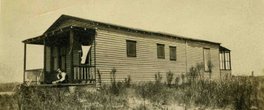Memorial Day is the day we remember the American veterans who fought and died in wars.
First in our line of veterans is Joseph Henry Ludwig, a hero of the Revolutionary War. I've already written about him. We might have other Revolutionary War veterans in the family, but he's the only one I've been able to document.
His grandson, Captain Joseph William Ludwig, commanded a steamship for the Union Navy during the Civil War. Born in Waldoboro, Maine, he was living in New York City at the start of the War. After the war, he lived in Jersey City.
William James Tibbitt of Elkton, Maryland, also served in the Union Navy; he served as a Landsman, which was the lowest rank at the time. But his service record indicates that he spent most of his enlistment in the Pacific Ocean. His gravestone in Elkton Cemetery has a GAR emblem.
James McDermond also served in the Civil war, as a sergeant. Like most able-bodied men in Pennsylvania, he was pressed into service in 1862 when rumors of a Confederate invasion spread. Any male able to carry a rifle was drafted to do just that. After a few months, almost all of them were released back to civilian life. But Sergeant McDermond was "Awarded for Distinguished Service" for his time with Company D, 21 Pennsylvania Vol. Infantry
Samuel Hudson Fisher II was only 17 years old in August 1862 when he enlisted as a drummer for the 114th PA Infantry, Company D. In December of 1863 he incurred a rupture while in Virginia, and was transferred to a Veteran's Hospital in Chicago. He was discharged in October 1864.
Interestingly, while he returned to Philadelphia to marry Josephine Weis, and definitely lived there, his son Samuel Hudson Fisher III was born in Chicago, Illinois in 1873. He died at age 45 at his home on Dean Street in Philadelphia.
By and large, most of the conflicts of the twentieth century spaced out such that the men of our family were either too young or too old to be called into wartime service. But we did have soldiers and sailors in the family;
Fred "Butch" Jahn, served in the Coast Guard through the 1960s and 1970s.
Winfield Tibbit served in Germany during the Cold War of the 1950s; S. Stewart Joslin III served there twenty years later as a tank commander.
We should be thankful for the sacrifices made by each generation; they bought us our freedom.
First in our line of veterans is Joseph Henry Ludwig, a hero of the Revolutionary War. I've already written about him. We might have other Revolutionary War veterans in the family, but he's the only one I've been able to document.
His grandson, Captain Joseph William Ludwig, commanded a steamship for the Union Navy during the Civil War. Born in Waldoboro, Maine, he was living in New York City at the start of the War. After the war, he lived in Jersey City.
William James Tibbitt of Elkton, Maryland, also served in the Union Navy; he served as a Landsman, which was the lowest rank at the time. But his service record indicates that he spent most of his enlistment in the Pacific Ocean. His gravestone in Elkton Cemetery has a GAR emblem.
James McDermond also served in the Civil war, as a sergeant. Like most able-bodied men in Pennsylvania, he was pressed into service in 1862 when rumors of a Confederate invasion spread. Any male able to carry a rifle was drafted to do just that. After a few months, almost all of them were released back to civilian life. But Sergeant McDermond was "Awarded for Distinguished Service" for his time with Company D, 21 Pennsylvania Vol. Infantry
Samuel Hudson Fisher II was only 17 years old in August 1862 when he enlisted as a drummer for the 114th PA Infantry, Company D. In December of 1863 he incurred a rupture while in Virginia, and was transferred to a Veteran's Hospital in Chicago. He was discharged in October 1864.
Interestingly, while he returned to Philadelphia to marry Josephine Weis, and definitely lived there, his son Samuel Hudson Fisher III was born in Chicago, Illinois in 1873. He died at age 45 at his home on Dean Street in Philadelphia.
By and large, most of the conflicts of the twentieth century spaced out such that the men of our family were either too young or too old to be called into wartime service. But we did have soldiers and sailors in the family;
Fred "Butch" Jahn, served in the Coast Guard through the 1960s and 1970s.
Winfield Tibbit served in Germany during the Cold War of the 1950s; S. Stewart Joslin III served there twenty years later as a tank commander.
We should be thankful for the sacrifices made by each generation; they bought us our freedom.

